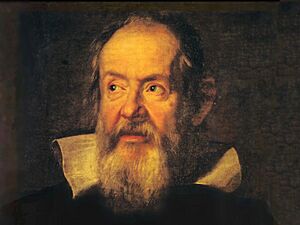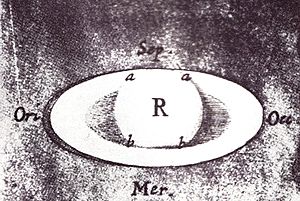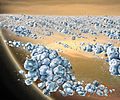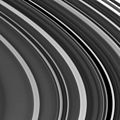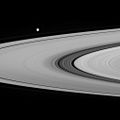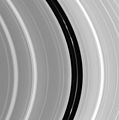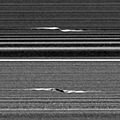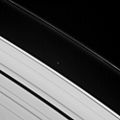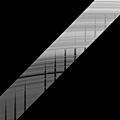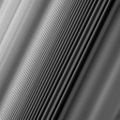Rings of Saturn facts for kids
The rings of Saturn are amazing circles of tiny pieces of ice and rock that spin around the planet Saturn. You can even see them with a small telescope! These rings are made of countless small bits, from tiny dust specks to chunks as big as a bus. All these pieces are mostly made of water ice, with a little bit of dust and other materials mixed in.
The rings have some empty spaces, like lanes on a highway. For example, the moon Pan helps create a gap called the "Encke Gap" in one of Saturn's main rings, the A ring. Another famous gap is the Cassini Division. This big space separates the A ring from the B ring. An Italian astronomer named Giovanni Domenico Cassini discovered it a long time ago.
Contents
How We Discovered Saturn's Rings
Early Views of Saturn
The first person to see Saturn's rings was Galileo Galilei in 1610. He used his telescope, but it wasn't strong enough to see them clearly. He thought Saturn had "ears" or was made of three planets touching each other! He was very confused when the rings seemed to disappear in 1612. This happened because Earth passed through the flat plane of the rings, making them invisible from our view. Galileo wondered if Saturn had "swallowed his children," like the old myth of the god Saturn.
Understanding the Rings
Many years later, in 1656, a Dutch scientist named Christiaan Huygens used a much better telescope. He was the first to correctly figure out that Saturn was surrounded by a thin, flat ring that didn't actually touch the planet. This was a huge discovery! Another scientist, Robert Hooke, also observed the rings and noticed the shadows they cast on Saturn.
In 1675, Giovanni Domenico Cassini made another important discovery. He realized that Saturn's ring wasn't just one big ring. Instead, it was made of many smaller rings with gaps between them. The biggest gap he found is now called the Cassini Division. It's a huge space, about 4,800 kilometers (3,000 miles) wide, between the A and B rings.
Later, in the 1800s, scientists like James Clerk Maxwell used math to prove that the rings couldn't be solid. They had to be made of countless tiny particles, each orbiting Saturn on its own. This idea was later confirmed by looking at the rings with special tools in 1895.
Exploring Saturn's Rings with Spacecraft
Over the years, four robotic spacecraft have flown past Saturn and given us amazing close-up views of its rings.
- The Pioneer 11 probe flew by in 1979 and discovered a new ring called the F ring.
- Voyager 1 visited in 1980 and showed us incredible details of the rings, even finding the G ring.
- Voyager 2 followed in 1981 and saw even more tiny ringlets that we had never seen before.
- The Cassini spacecraft orbited Saturn from 2004 to 2017. It sent back the most detailed pictures of the rings ever! Cassini helped us discover even more ringlets and understand how they work.
The main rings of Saturn are named with letters, starting from the closest to the planet and moving outwards: C, B, and A. The D Ring is very faint and closest to Saturn. The F Ring is a narrow ring just outside the A Ring. Beyond that are the fainter G and E rings. The rings have so much detail, and scientists are still learning about how Saturn's moons affect them.
Images for kids
-
The full set of rings, seen when Saturn blocked the Sun from the Cassini spacecraft in 2013. Earth looks like a tiny dot!
-
A drawing of Saturn by Galileo Galilei from 1610.
-
The Cassini Division seen from the Cassini spacecraft. The moon Mimas is in the background.
-
Pan's orbit lines up with the central ringlet of the A Ring's Encke Gap.
-
Waves in the Keeler gap caused by the moon Daphnis.
-
The Anthe Ring Arc – the bright spot is Anthe.
-
A spiral wave in Saturn's inner B Ring caused by the moon Janus.
-
Dark B Ring spokes in a Cassini image of the rings' unlit side.
-
Cassini image of the sun-lit side of the rings taken in 2009, showing bright B Ring spokes.
-
A stretched view of the Keeler Gap edge waves caused by Daphnis.
-
Prometheus carving a dark channel in the F Ring.
-
The F ring changing, likely due to small moons nearby.
-
Saturn's shadow cuts off the backlit G Ring and its bright inner arc.
See also
 In Spanish: Anillos de Saturno para niños
In Spanish: Anillos de Saturno para niños


